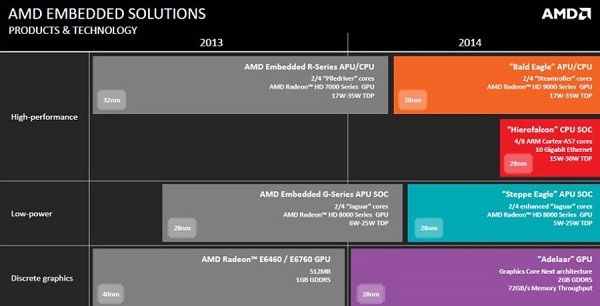[caption id="attachment_12200" align="aligncenter" width="600"] AMD lays out roadmap for datacenter, smart-device Systems-on-a-Chip[/caption] Advanced Micro Devices (AMD) has announced three new families of microprocessors designed to power everything except PCs, along with one designed specifically to provide embedded intelligence for datacenter equipment. All four families are meant to support low-power, multicore processors designed for highly connected, power-conserving smart devices, though one is designed for embedded x86-based systems, one is a dedicated graphics processor, and two are Systems-on-a-Chip (SoC). The microprocessors will serve a range of functions far more complex than simply devices within the "Internet of Things" that demand low-power processors and little else. The most ambitious is "Hierofalcon," a 64-bit ARM-based CPU and SoC designed specifically for communications and networking within a datacenter. Initial versions will include up to eight Cortex –A57 CPU cores running at speeds up to 2 GHz, with two channels for 64-bit DDR3/4 memory, a cryptographic co-processor for advanced encryption, and direct support for 10Gbit/sec Ethernet network connections and PCI-Express Gen 3 interconnects. AMD did not say whether Hierofalcon would include the Freedom Fabric high-speed multi-server interconnect AMD announced in July along with its "Seattle" SoC as part of its push beyond the PC market and into competition for datacenter servers, storage, networking and other devices. The newly announced Hierofalcon is basically the embedded version of Seattle, which is designed specifically as a server processor, according to Arun Iyengar, VP and general manager of AMD's Embedded Solutions, quoted by The Register as he spoke from yesterday's press event. (A copy of Iyengar's presentation slideshow is available here.) While Seattle is aimed at servers, "Hierofalcon is targeted towards the other elements of a data center, which are the communications, networking, and storage sides," he said. Hierofalcon is the only completely new family of chips on the list of four that AMD announced. "Adelar" is a GPU based on AMD's Radeon E6460/E6760 processors and its "Graphics Core Next" graphics architecture. "Steppe Eagle" is the next generation of AMD's G-Series SoC, and will ship with either two- or four cores from AMD's "Jaguar" series, but will have lower power requirements than its predecessors. "Bald Eagle" is a CPU/application-accelerator designed to replace AMD's 32nm R-Series of embedded processors, with an updated system core and graphics upgrade from the Radeon HD 7000 to the HD 9000. Despite the launch of a datacenter-specific processor and higher-level graphics and communications functions, AMD executives said all four new processors (all given raptor code-names) are part of the company's effort to change its business model to the point where half its revenue comes from its traditional x86 business and the rest comes from non-PC devices. The 50-percent mark, however, "does include things such as the dense server–that's a new application, that's part of the 50 percent," Iyengar said during the event. "It also includes new form factors within the client space" such as tablets, smartphones, smartwatches and almost any other piece of hardware that needs a little intelligence. Hierofalcon won't be as power-sipping as the processors designed for embedded systems. It will come in versions pulling either 15 watts or 30 watts and will compete primarily with Intel's 22nm Rangeley Atom-based SoC, which is already on the market. AMD plans to distribute samples of Hierofalcon to OEMs during the second quarter of 2014; production systems based on it should appear during the second half of 2014, according to the company. Image: AMD
AMD lays out roadmap for datacenter, smart-device Systems-on-a-Chip[/caption] Advanced Micro Devices (AMD) has announced three new families of microprocessors designed to power everything except PCs, along with one designed specifically to provide embedded intelligence for datacenter equipment. All four families are meant to support low-power, multicore processors designed for highly connected, power-conserving smart devices, though one is designed for embedded x86-based systems, one is a dedicated graphics processor, and two are Systems-on-a-Chip (SoC). The microprocessors will serve a range of functions far more complex than simply devices within the "Internet of Things" that demand low-power processors and little else. The most ambitious is "Hierofalcon," a 64-bit ARM-based CPU and SoC designed specifically for communications and networking within a datacenter. Initial versions will include up to eight Cortex –A57 CPU cores running at speeds up to 2 GHz, with two channels for 64-bit DDR3/4 memory, a cryptographic co-processor for advanced encryption, and direct support for 10Gbit/sec Ethernet network connections and PCI-Express Gen 3 interconnects. AMD did not say whether Hierofalcon would include the Freedom Fabric high-speed multi-server interconnect AMD announced in July along with its "Seattle" SoC as part of its push beyond the PC market and into competition for datacenter servers, storage, networking and other devices. The newly announced Hierofalcon is basically the embedded version of Seattle, which is designed specifically as a server processor, according to Arun Iyengar, VP and general manager of AMD's Embedded Solutions, quoted by The Register as he spoke from yesterday's press event. (A copy of Iyengar's presentation slideshow is available here.) While Seattle is aimed at servers, "Hierofalcon is targeted towards the other elements of a data center, which are the communications, networking, and storage sides," he said. Hierofalcon is the only completely new family of chips on the list of four that AMD announced. "Adelar" is a GPU based on AMD's Radeon E6460/E6760 processors and its "Graphics Core Next" graphics architecture. "Steppe Eagle" is the next generation of AMD's G-Series SoC, and will ship with either two- or four cores from AMD's "Jaguar" series, but will have lower power requirements than its predecessors. "Bald Eagle" is a CPU/application-accelerator designed to replace AMD's 32nm R-Series of embedded processors, with an updated system core and graphics upgrade from the Radeon HD 7000 to the HD 9000. Despite the launch of a datacenter-specific processor and higher-level graphics and communications functions, AMD executives said all four new processors (all given raptor code-names) are part of the company's effort to change its business model to the point where half its revenue comes from its traditional x86 business and the rest comes from non-PC devices. The 50-percent mark, however, "does include things such as the dense server–that's a new application, that's part of the 50 percent," Iyengar said during the event. "It also includes new form factors within the client space" such as tablets, smartphones, smartwatches and almost any other piece of hardware that needs a little intelligence. Hierofalcon won't be as power-sipping as the processors designed for embedded systems. It will come in versions pulling either 15 watts or 30 watts and will compete primarily with Intel's 22nm Rangeley Atom-based SoC, which is already on the market. AMD plans to distribute samples of Hierofalcon to OEMs during the second quarter of 2014; production systems based on it should appear during the second half of 2014, according to the company. Image: AMD
